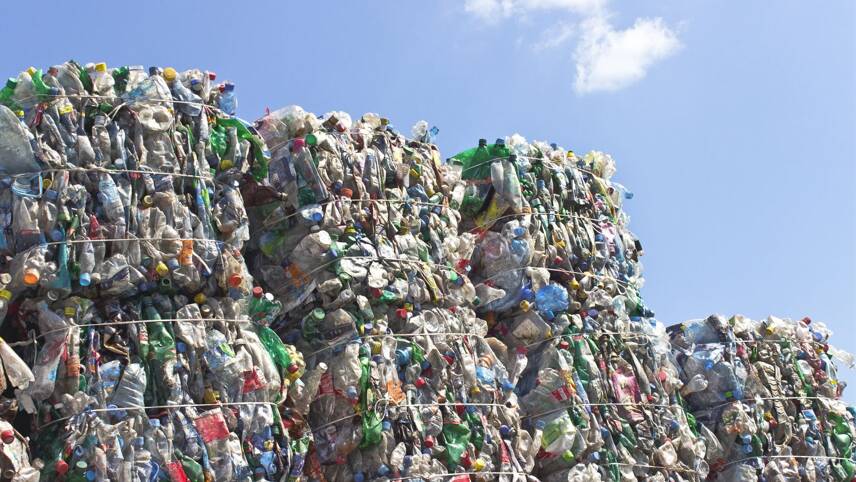Register for free and continue reading
Join our growing army of changemakers and get unlimited access to our premium content

Published today (4 April), the ‘Reshaping Plastics’ report was commissioned by trade association Plastics Europe and produced by environmental consultancy Systemiq. It maps how compatible the current plastics lifecycle is with EU and UK climate and resource goals, and sets out a pathway to shifting plastics systems across the continent so they become “circular and climate-neutral” by mid-century. The whole life-cycle of plastics is covered in the analysis.
On circularity, the report outlines how Europe uses 44 million tonnes of virgin fossil-based plastics each year. The continent has a slightly higher plastics recycling rate than the global average – 14% compared to 9%. It notes that, by 2030, on a trajectory based on current national, business and international commitments being delivered, 33% of all plastic produced in 2030 would be either recycled, reused or used for energy-from-waste (EfW).
This proportion will not be sufficient to align the plastics value chain with long-term policy goals on resources or with the 2050 net-zero pledges from the UK and EU, the report warns. Concerns are raised around how, as more renewable energy generation capacity comes online, EfW using plastics will become “comparatively worse” in terms of environmental impact.
On this trajectory, Europe would still be using 37 million tonnes of virgin fossil-based plastics each year in 2050. Use would have only fallen 16% against a 2020 baseline. As for emissions, the report forecasts an 18% decrease between 2020 and 2050 in this scenario. This would leave the sector overly reliant on offsetting, insetting and carbon capture technologies which are not yet commercially mature to reach net-zero.
“A circular, net-zero plastics system in Europe is within reach, but it will require enhanced ambitions and bold decisions,” the report states.“The next three to five years are a critical window for action. Long technology maturity cycles and capex lock-in for large infrastructure investments mean that the decisions taken in the early 2020s will determine whether or not the European plastics system will achieve a circular economy and net-zero greenhouse gas emissions by 2050.”
Transformational change
The report sets out three scenarios in which the European plastics value chain is shifted in a way that makes it compatible with net-zero by 2050. In all three scenarios, the circularity rate reaches 78%, up from 14% at present. None of the scenarios will see Europe consuming more than 20 million tonnes of virgin fossil-based plastics annually from 2050 – a reduction of at least 45%. The scenarios all detail emissions reductions, against a 2020 baseline, of more than 70%.
Each scenario comes with a price tag of between €160bn and €180bn through to 2050. The report argues that public and private finance should play a role.
The report recommends that policymakers go further to implore the sector to eliminate unnecessary plastic in the first instance. Items that are hard-to-recycle and/or frequently littered should be eliminated by smart redesign, and by the introduction of reusables where possible and material substitutions where not.
This move alone could prevent the generation of five million tonnes of plastic waste per year by 2030, according to the report. Substitution of additional items, not necessarily deemed “unnecessary”, would mitigate a further 1.5 million tonnes of plastic waste per year by 2030.
The report also details measures to scale mechanical recycling capacity almost twofold this decade, while also improving collection and sorting simultaneously. At the same time, chemical recycling must be scaled – but the report does caution that it will scale more rapidly in the 2030s and 2040s than it will this decade.
In the scenarios detailed, European nations also eliminate the export of plastic waste to other countries. This ensures that Europe is not “offshoring” the problem and should also stimulate local investment, maximising job creation opportunities and wider economic benefits. Several nations which have, historically, led on plastic waste imports have now moved to ban them, including China and Vietnam. The EU and UK are already working towards commitments to end the export of plastic waste to non-OECD countries.
On emissions specifically, all three scenarios involve government incentives and business investments to remove fossil fuels from plastics manufacturing and recycling. The report highlights green hydrogen and biofuels for steam cracking facilities which usually use fossil-fuel-based gases, for example. Energy efficiency and recovery systems will also need to be fitted, as will carbon capture technologies.
The current state of play globally
The new ‘Reshaping Plastics’ report includes many of the same warnings as a major report on the global state of plastics production and pollution issued by the OECD in February.
That report revealed that the growth of the plastics market has outpaced economic growth by almost 40%, with recycling systems unable to scale in tandem with increased production. This has resulted in more littering, landfilling and incineration, which has pushed the emissions footprint of the plastics lifecycle higher.
Shortly after the OECD report was issued, the UN wrapped up its latest Environment Assembly conference in Nairobi, with attendees agreeing on the broad terms of a new global treaty to end plastic pollution.The treaty will cover the full lifecycle of plastic, from production to waste management. It will cover plastics of all types and sizes, right down to nurdles and microplastics. The final treaty is expected to be ratified by 2024.

